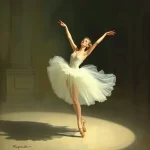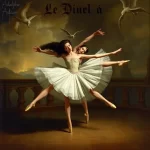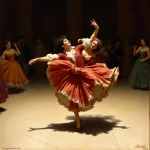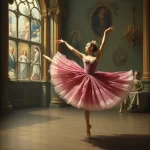Ballet: Raymonda (Alexander Glazunov, 1898)

Introduction
Ballet, a classical dance form known for its grace and precision, has produced numerous masterpieces over the centuries. One such gem is “Raymonda,” a ballet composed by Alexander Glazunov in 1898. Choreographed by the legendary Marius Petipa, “Raymonda” premiered at the Mariinsky Theatre in St. Petersburg, Russia. The ballet is a romantic tale set in the medieval period, revolving around themes of love, chivalry, and heroism.
Historical Background
Creation and Development
“Raymonda” was created during a period of significant cultural and artistic development in Russia. The late 19th century was a time when Russian ballet was flourishing, with the Imperial Ballet (now the Mariinsky Ballet) at its zenith. The ballet was inspired by medieval chivalric romances and folklore, which were popular themes in literature and art at the time.
The collaboration between Marius Petipa, the choreographer, and Alexander Glazunov, the composer, was pivotal in bringing “Raymonda” to life. Petipa, known for his meticulous and innovative choreography, worked closely with Glazunov, whose music perfectly complemented the ballet’s romantic and heroic themes. The libretto was written by Lydia Pashkova, adding a literary depth to the ballet’s narrative.
Premiere and Reception
“Raymonda” premiered on January 19, 1898, at the Mariinsky Theatre in St. Petersburg. The initial reception was mixed; while the choreography and music were praised, the complex plot received some criticism. However, over time, “Raymonda” gained recognition for its artistic brilliance and became a staple in the ballet repertoire.
Notable early performances included those by renowned ballerinas such as Pierina Legnani, who originated the role of Raymonda. The ballet saw several revivals, each adding new dimensions to its interpretation and performance.
Synopsis of the Ballet
Act I Summary
The ballet opens in the castle of Countess Sybille, where preparations are underway for the name day celebration of her niece, Raymonda. Raymonda is betrothed to Jean de Brienne, a knight who is away on a crusade. During the festivities, Raymonda has a vision of Jean, but it is interrupted by the arrival of Abderakhman, a Saracen knight who is captivated by Raymonda’s beauty. He declares his love for her, but she rejects him.
Act II Summary
In Act II, the celebrations continue with various dances and entertainments. Abderakhman tries to win Raymonda’s favor with lavish gifts and a passionate dance, but she remains steadfast in her loyalty to Jean. The tension escalates as Abderakhman becomes more insistent, leading to a dramatic confrontation.
Act III Summary
Act III brings the climax and resolution of the ballet. Jean de Brienne returns just in time to challenge Abderakhman to a duel. The two knights engage in a fierce battle, with Jean emerging victorious. The ballet concludes with a grand wedding celebration for Raymonda and Jean, symbolizing the triumph of love and honor.
Finale
The finale of “Raymonda” is a grand spectacle, featuring elaborate dances and a joyful celebration of the union between Raymonda and Jean. The conclusion underscores the themes of chivalry and true love, leaving the audience with a sense of fulfillment and admiration for the characters’ bravery and devotion.
Musical Composition
Composer’s Role
Alexander Glazunov, a prominent Russian composer, played a crucial role in the creation of “Raymonda.” His score is celebrated for its rich orchestration and melodic beauty, which perfectly capture the ballet’s romantic and heroic essence. Notable pieces within the score include the “Grand Pas Classique” and the “Hungarian Dance,” both of which are highlights of the ballet.
Musical Themes and Motifs
Glazunov’s music for “Raymonda” features recurring themes and leitmotifs that enhance the narrative and emotional depth of the ballet. The use of leitmotifs helps to establish character identities and underscore key moments in the story. For example, Raymonda’s theme is lyrical and tender, reflecting her purity and grace, while Abderakhman’s theme is bold and exotic, highlighting his passionate and forceful nature.
Famous Recordings and Performances
Several iconic recordings and performances of “Raymonda” have been made over the years. Notable recordings include those conducted by Evgeny Svetlanov and Valery Gergiev, both of which capture the grandeur and intricacy of Glazunov’s score. Renowned ballet companies such as the Bolshoi Ballet and the Mariinsky Ballet have staged memorable performances, showcasing the ballet’s enduring appeal.
Choreography and Dance
Choreographer’s Vision
Marius Petipa’s vision for “Raymonda” was one of elegance and technical brilliance. His choreography is characterized by intricate footwork, graceful port de bras, and elaborate group formations. Petipa’s attention to detail and his ability to convey the story through dance are evident throughout the ballet.
Signature Dance Numbers
“Raymonda” features several signature dance numbers that have become iconic in the world of ballet. The “Grand Pas Classique” in Act III is a highlight, showcasing the technical prowess of the lead dancers. The “Hungarian Dance” is another standout, with its lively rhythms and vibrant choreography reflecting the cultural influences of the story.
Notable Interpretations
Over the years, different productions of “Raymonda” have brought unique interpretations to the choreography. Some have emphasized the romantic elements, while others have focused on the ballet’s heroic and dramatic aspects. Notable interpretations include those by Rudolf Nureyev and Yuri Grigorovich, both of whom added their own creative touches to Petipa’s original choreography.
Characters and Roles
Main Characters
- Raymonda: The protagonist, a noble and beautiful young woman betrothed to Jean de Brienne.
- Jean de Brienne: A knight and Raymonda’s fiancé, known for his bravery and chivalry.
- Abderakhman: A Saracen knight who falls in love with Raymonda and becomes the antagonist.
Supporting Characters
- Countess Sybille: Raymonda’s aunt and guardian, who hosts the name day celebration.
- Henriette and Clémence: Raymonda’s friends, who participate in the festivities and support her throughout the story.
Famous Dancers
Many renowned dancers have portrayed the roles in “Raymonda” over the years. Pierina Legnani, who originated the role of Raymonda, set a high standard for future ballerinas. Other notable dancers include Galina Ulanova, Natalia Makarova, and Svetlana Zakharova, each bringing their own interpretation and artistry to the role.
Cultural and Artistic Impact
Influence on Ballet and Dance
“Raymonda” has had a significant influence on the world of ballet and dance. Its intricate choreography and rich musical score have inspired countless choreographers and dancers. The ballet’s emphasis on technical precision and expressive storytelling has contributed to the development of ballet as an art form.
Cultural Significance
The cultural significance of “Raymonda” extends beyond the ballet stage. Its themes of love, honor, and heroism resonate with audiences and have been referenced in literature, film, and other media. The ballet’s medieval setting and romantic narrative continue to captivate and inspire artists and audiences alike.
Legacy and Revivals
“Raymonda” has seen numerous revivals and reinterpretations over the years. Major ballet companies around the world continue to perform the ballet, keeping its legacy alive. Modern adaptations have introduced new elements while preserving the essence of Petipa’s original choreography and Glazunov’s music.
Iconic Productions
Historic Productions
Some of the most famous historical productions of “Raymonda” include those by the Mariinsky Ballet and the Bolshoi Ballet. These productions featured legendary dancers and choreographers, such as Galina Ulanova and Yuri Grigorovich, who brought their own unique interpretations to the ballet.
Contemporary Productions
Recent productions of “Raymonda” have continued to explore new creative possibilities. Companies like the Royal Ballet and the American Ballet Theatre have staged contemporary versions that incorporate modern elements while staying true to the original spirit of the ballet. These productions often feature innovative set and costume designs, adding a fresh perspective to the classic tale.
Production Design
The production design of “Raymonda” plays a crucial role in bringing the medieval setting and romantic narrative to life. Elaborate sets, opulent costumes, and atmospheric lighting all contribute to the visual splendor of the ballet. Notable designers such as Nicholas Georgiadis and Franca Squarciapino have created stunning designs that enhance the overall experience of the ballet.
Critical Reception and Reviews
Initial Critical Response
At the time of its premiere, “Raymonda” received mixed reviews from critics. While the choreography and music were praised for their artistic excellence, the complex plot was seen as a drawback. However, the ballet’s visual and technical brilliance soon won over audiences and critics alike, establishing it as a significant work in the ballet repertoire.
Modern Reviews
Contemporary critics and audiences continue to appreciate “Raymonda” for its artistic and technical achievements. The ballet is celebrated for its intricate choreography, beautiful music, and compelling narrative. Modern reviews often highlight the enduring appeal of the ballet and its relevance in today’s cultural landscape.
Fun Facts and Trivia
Behind-the-Scenes Stories
One interesting anecdote from the production of “Raymonda” involves Pierina Legnani, the original Raymonda. Known for her incredible technical skills, Legnani was famous for performing 32 fouettés en tournant, a feat that became a hallmark of the role and a challenge for future ballerinas.
Notable Performers
Over the years, many famous dancers have been associated with “Raymonda.” Rudolf Nureyev, a legendary dancer and choreographer, created his own version of the ballet, which remains one of the most celebrated interpretations. Other notable performers include Margot Fonteyn, Maya Plisetskaya, and Alina Cojocaru.
Trivia
- “Raymonda” is one of the few ballets where the composer, Alexander Glazunov, attended almost every rehearsal, ensuring that the music perfectly matched the choreography.
- The ballet’s “Hungarian Dance” is often performed as a standalone piece in ballet galas and competitions due to its vibrant and technically demanding choreography.
- Marius Petipa was 80 years old when he choreographed “Raymonda,” showcasing his enduring creativity and passion for ballet.
Conclusion
Summary of the Ballet’s Importance
“Raymonda” holds a significant place in the world of ballet due to its artistic brilliance, intricate choreography, and beautiful music. The collaboration between Marius Petipa and Alexander Glazunov resulted in a masterpiece that continues to inspire and captivate audiences worldwide.
Final Thoughts
“Raymonda” is a testament to the enduring power of classical ballet. Its themes of love, honor, and heroism resonate across generations, making it a timeless work of art. Whether you are a seasoned ballet enthusiast or a newcomer to the art form, “Raymonda” offers a rich and rewarding experience that is well worth exploring.
What is the central theme of this ballet?
The central theme of “Raymonda” revolves around love, chivalry, and heroism, set against a backdrop of medieval romance and adventure.
Who are the main characters in this ballet?
The main characters in “Raymonda” are Raymonda, Jean de Brienne, and Abderakhman.
What is the most famous dance number in this ballet?
The “Grand Pas Classique” in Act III is one of the most famous dance numbers in “Raymonda,” showcasing the technical prowess of the lead dancers.
How long does a typical performance of this ballet last?
A typical performance of “Raymonda” lasts approximately two and a half to three hours, including intermissions.
Are there any modern adaptations of this ballet?
Yes, there have been several modern adaptations of “Raymonda,” with contemporary productions incorporating new elements while preserving the essence of the original ballet.
Why is this ballet considered important in the history of dance?
“Raymonda” is considered important in the history of dance due to its artistic excellence, intricate choreography, and beautiful music. It has influenced countless choreographers and dancers and remains a staple in the ballet repertoire.





